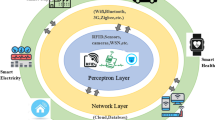Abstract
The trustworthiness and connectivity of the network depends on the energy drain rate of mobile nodes. Colluders like vampire nodes in ad hoc network make it more vulnerable as they rapidly drain considerable amount of energy. This generic vampire attacks seem to capitalize on the potential features of the incorporated baseline protocol used for facilitating trustworthy data dissemination. The main goal of this paper is to formulate an attack prevention scheme that uses fuzzy trust relationship perspective for detecting vampire attacks and enforcing reduced energy drain rate of colluding mobile nodes. This fuzzy trust relationship perspective-based prevention mechanism (FTRPPM) initially estimates the associative trust and associative reputation of mobile nodes. Further, it quantifies the impact of factors that could induce vampire attack in the network under its influence. Finally, it facilitates the detection of vampire nodes based on the established ranges of threshold that are dynamically adjusted based on quantified level of probability factor. The empirical and simulation results of FTRPPM is confirmed to be exceptional as it ensures a remarkable improvement in mean PDR of 16% and mean throughput of 14% under the impact of increasing number of mobile nodes on par with the existing vampire attack mitigation schemes.












Similar content being viewed by others
References
Macker, J. P., & Corson, M. S. (2005). Mobile ad hoc networks (MANETs): Routing technology for dynamic wireless networking. Mobile Ad Hoc Networking, 2(1), 255–273.
Feeney, L. M. (2005). Energy-efficient communication in ad hoc wireless networks. Mobile Ad Hoc Networking, 3(1), 301–327.
Poturalski, M., Papadimitratos, P., & Hubaux, J. (2013). Formal analysis of secure neighbor discovery in wireless networks. IEEE Transactions on Dependable and Secure Computing, 10(6), 355–367.
Papadimitratos, P., Poturalski, M., Schaller, P., Lafourcade, P., Basin, D., Capkun, S., et al. (2008). Secure neighborhood discovery: A fundamental element for mobile ad hoc networking. IEEE Communications Magazine, 46(2), 132–139.
Zhong, S., & Wu, F. (2007). On designing collusion-resistant routing schemes for non-cooperative wireless ad hoc networks. In Proceedings of the 13th annual ACM international conference on Mobile computing and networking—MobiCom’07 (Vol. 1, No. 2, pp. 33–42).
Altman, E., Avrachenkov, K., & Garnaev, A. (2009). Jamming in wireless networks under uncertainty. In 2009 7th international symposium on modeling and optimization in mobile, ad hoc, and wireless networks (Vol. 1, No. 1, pp. 23–35).
Jaramillo, J. J., & Srikant, R. (2007). DARWIN. In Proceedings of the 13th annual ACM international conference on Mobile computing and networking—MobiCom’07 (Vol. 1, No. 1, pp. 11–22).
Li, F., & Wu, J. (2008). Hit and run: A Bayesian game between malicious and regular nodes in MANETs. In 2008 5th annual IEEE communications society conference on sensor, mesh and ad hoc communications and networks (Vol. 2, No. 1, pp. 23–34).
Li, X., Wu, Y., Xu, P., Chen, G., & Li, M. (2008). Hidden information and actions in multi-hop wireless ad hoc networks. In Proceedings of the 9th ACM international symposium on mobile ad hoc networking and computing and advancement—MobiHoc’08 (Vol. 2, No. 1, pp. 12–24).
Cardenas, A. A., Radosavac, S., & Baras, J. S. (2007). Performance comparison of detection schemes for MAC layer misbehavior. In IEEE INFOCOM 2007—26th IEEE international conference on computer communications (Vol. 1, No. 2, pp. 43–52).
Joo, C., & Shroff, N. B. (2007). Performance of random access scheduling schemes in multi-hop wireless networks. In IEEE INFOCOM 2007—26th IEEE international conference on computer communications (Vol. 3, No. 1, pp. 24–31).
Bhatia, R., Kashyap, A., & Li, L. (2007). The power balancing problem in energy constrained multi-hop wireless networks. In IEEE INFOCOM 2007—26th IEEE international conference on computer communications (Vol. 1, No. 1, pp. 67–78).
Deng, J., Han, R., & Mishra, S. (2005). Defending against path-based DoS attacks in wireless networks. In Proceedings of the 3rd ACM workshop on security of ad hoc and sensor networks—SASN’05 (Vol. 2, No. 1, pp. 23–34).
Aad, I., Hubaux, J., & Knightly, E. W. (2004). Denial of service resilience in ad hoc networks. In Proceedings of the 10th annual international conference on Mobile computing and networking—MobiCom’04 (Vol. 1, No. 1, pp. 45–56).
Doshi, S., Bhandare, S., & Brown, T. X. (2002). An on-demand minimum energy routing protocol for a wireless ad hoc network. ACM SIGMOBILE Mobile Computing and Communications Review, 6(3), 50.
Fotino, M., & De, F. (2011). Energy issues and energy aware routing in wireless ad hoc networks. Mobile Ad-Hoc Networks: Protocol Design, 2(2), 45–61.
Stojmenovic, I., & Lin, X. (2001). Power-aware localized routing in wireless networks. IEEE Transactions on Parallel and Distributed Systems, 12(11), 1122–1133.
Raikwar, M., & Mishra, P. (2017). A mitigation approach to protect wireless sensor networks over vampire attack. International Journal of Computer Applications, 159(7), 25–28.
Vasserman, E. Y., & Hopper, N. (2013). Vampire attacks: Draining life from wireless ad hoc sensor networks. IEEE Transactions on Mobile Computing, 12(2), 318–332.
Ye, J., & Dang, Y. (2017). A novel grey fixed weight cluster model based on interval grey numbers. Grey Systems: Theory and Application, 2(2), 12–22.
Author information
Authors and Affiliations
Corresponding author
Additional information
Publisher's Note
Springer Nature remains neutral with regard to jurisdictional claims in published maps and institutional affiliations.
Rights and permissions
About this article
Cite this article
Balaji Srikaanth, P., Nagarajan, V. A Fuzzy Trust Relationship Perspective-Based Prevention Mechanism for Vampire Attack in MANETs. Wireless Pers Commun 101, 339–357 (2018). https://doi.org/10.1007/s11277-018-5691-8
Published:
Issue Date:
DOI: https://doi.org/10.1007/s11277-018-5691-8




